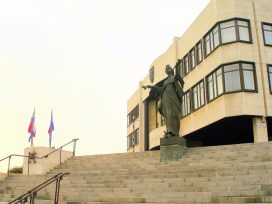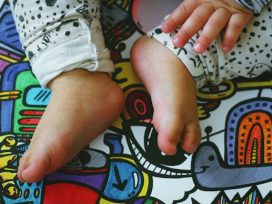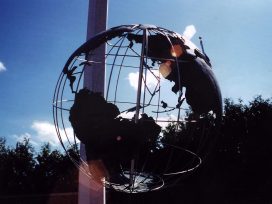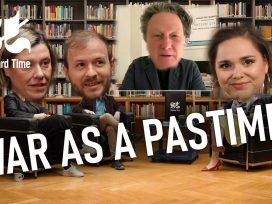Veronica Kaup-Hasler is a dramaturge, festival curator, cultural manager and politician. Born in Dresden in in 1968, she began her professional career as a dramaturge at the Basel Theatre, where she worked between 1993 and 1995. From 1995 to 2001 she was part of the dramaturge collective of the Vienna Gala Weeks and in 2000 collaborated with director Christoph Schlingensief in his controversial artistic intervention Foreigners Out!
From 2001 to 2004 she curated the Theaterformen festival, which under her leadership was designed as a space for contemporary stage practices and the crossing of borders between different artistic genres. In her professional work, she made her greatest mark while managing the Styrian Autumn Festival (Steirischer Herbst), which she curated between 2006 and 2017. This is a festival where contemporary performative practices and discourse on art and politics all have a place and is characterized by interdisciplinarity. In May 2018 she was appointed Executive City Councillor for Cultural Affairs and Science for the City of Vienna.
Veronica Kaup-Hasler visited Slovenia in March 2018, together with dramaturge and journalist Claus Philipp, at the invitation of the Slovenian Youth Theatre, which with the support of the Goethe Institute of Ljubljana and the Academy of Theatre, Radio, Film and Television, prepared the programme Focus: Schlingensief, dedicated to the artistic and political work of Christoph Schlingensief. There, she spoke to Blaž Gselman for Dialogi.
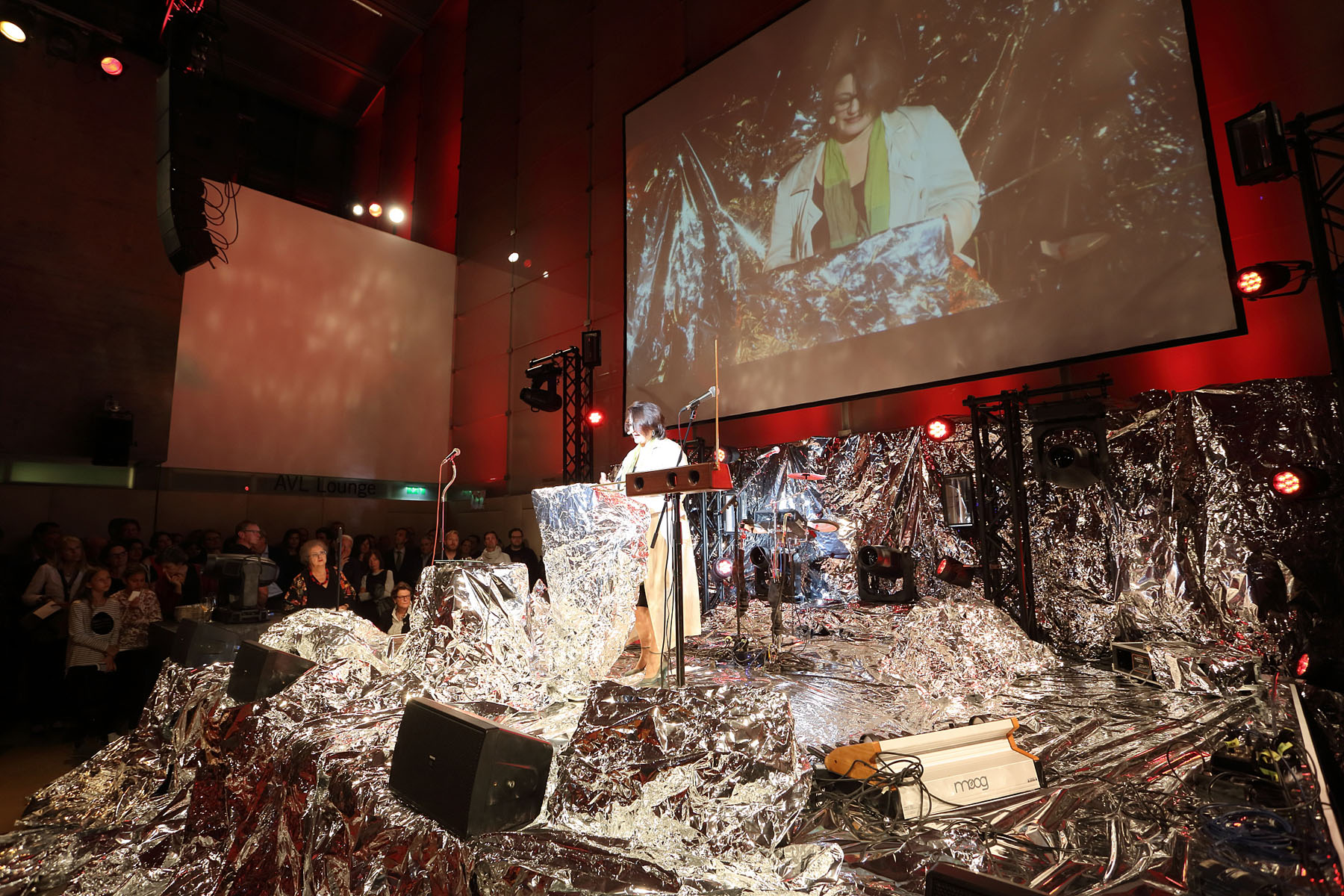
Veronica Kaup-Hasler opening Steirischer Herbst (2016). Photo credit: JJ Kucek
Blaž Gselman: I would like to start with a question that was the motto of last year’s Styrian Autumn Festival: Where are we now? Where do we actually stand at the moment?
Veronica Kaup-Hasler: This is a question that has accompanied me all my life, I would say. On the one hand, it is a working tool for me when I talk to artists whom I am just getting to know or have already worked with: the consequences of questioning yourself every day, and asking yourself what kind of society we currently live in; what is Europe like today, what are the topics we need to talk about; and what are the priority issues we need to deal with in our daily lives. For me it is a key question at many levels: professional, artistic, theoretical and personal. Trying to find a way to map your times, even if the map is not two-dimensional but multi-layered. Starting from here, it is always of key importance for me to refocus on what needs to be done. But, since you are asking me where we are now: well, I don’t know, of course. Especially now, we are all highly concerned about the development of Europe, and the profound identity crisis of what Europe might be or become. And, also, about the huge shift to the right which, in my view, can be seen at various levels. Therefore, I think it is a crucial moment for us to rediscover and redefine democracy in these challenging times.
Regarding the political aspect of the question ‘where are we now?’ – can we talk about fascism today, especially when taking into account the current Austrian government with the FPÖ, the AfD in Germany, Donald Trump, and so on?
As well as Hungary, Poland, Turkey, Slovakia, the Czech Republic, Italy, and many others. I think that what was in balance for a certain time has now shifted massively to the right. But I don’t know if I should call it fascism or rather a complete destruction of politics itself, an obliteration of politics that gives way to all kinds of populist ideas. In fact, populism is rising at all levels. And populism is not a monopoly of right-wing politics, as we can see clearly in Austria. What is frightening right now is not just that populists are disrespecting the diversity of opinions in the critical media, but also the lack of opposition or powers of opposition. There is no thorough analysis of what socialism could stand for, or how it could be defined in the 21st century. Or take the Green Party, which is completely destroyed in Austria. So there are no alternatives remaining to this kind of populism. There are clearly fascist tendencies, but I would say that this is not the prevailing phenomenon, as opposed to the populist view that ‘the majority reigns, whatever we do’. If you look at TV programming, it is entirely governed by audience numbers, ratings, et cetera. There is no vision behind television or radio programming right now.
From the broader socio-political perspective to the world of art: how can art intervene, or does art have the power to change the balance of forces?
The cynical part of me would answer this with ‘of course not’. But the working, pragmatic part of me (laughs)… Well, I could not live and work without the hope that a difference can be made. I think what I can clearly state is that art makes a difference. The question is not if we always succeed. In bits and pieces, yes. The project Ausländer raus! (Foreigners out!) by Christoph Schlingensief, which is still one of the key moments in my career as a programme curator, was so visionary it could still be staged today. You could transfer it to today and it would be as resonant as it was in 2000, if not more so. After all, back in 2000 we didn’t yet have the kind of international migration flow we see today. But at that time, we had the first severe laws concerning migration in Austria. The very first dated from the ’90s and was implemented by the Socialists. We should not forget that the reason for this paradoxical decision was because they were afraid of the populist party the FPÖ, the Austrian Freedom Party. And by this act, the Socialist party wanted to send a populist signal to rightwing voters.
With the Schlingensief container project, we managed to make the media protagonists and show their effective role in society. I think it changed Austria for a certain time and also woke people up in the debates as to what the ‘Big Brother idea’ means if you just shift the parameters of migration and stage a game on TV. This was one example of art working in this sense, and there are other examples, too. Making things transparent, addressing issues that today’s political protagonists would never address. I think this is clearly a role art can play. In the last twenty years, art and activism have moved closer together. In 2012 we made a huge, one-week 24/7 marathon with people working in the world of art coming out of their ivory towers, their museums and theatre spaces, in order to make projects really in society, in situ. We also involved politicians like Antanas Mockus, who came from politics but works with artistic means. So this kind of concrete work, where art intervenes in society, is clearly increasing. In my view, looking at a very specific local level, this means and changes a lot. Otherwise, we would not see so many artists imprisoned or threatened. There is a long list of artists who are really dangerous to the political sphere around them.
Just as today we have political elites who are alienated from the population, so it can be dangerous if art is kept inside the institution. But, as you pointed out, art has to be conscious of the fact that it must go outside its privileged spaces.
And leave the bubble behind. Absolutely. There is one wonderful example of a total intervention of art in politics: Emil Hrvatin and his group changing their names to Janez Janša. In Slovenia, you have examples of artists who went far beyond the normal limits of their own environment. So questioning the bubble and questioning what we can do while remaining aware of the fact that art still has to be so free – that it must also be possible in these times to not be involved in politics in the activist sense, and still produce high-quality art. Yes, the last huge step outside the bubble was last year when we did Children of the Dead, a novel by Elfriede Jelinek that has been totally neglected in Austria so far, also by major literary circles. It was always very painful for her to see that it was not appreciated and not received well. This novel takes place in a certain area in Upper Styria. What we did was this: we asked Nature Theater of Oklahoma to come up with their own vision and version of the book. It was a long process involving the countryside, farmers, normal people who had never encountered any form of contemporary art. I had the privilege of being in charge of the Styrian Autumn Festival, and I could plan this work to last two-and-a-half years in total, including preparation. We had plenty of time to talk to people, to have conversations with the mayor of a small village who later on turned out to be the chief protagonist in the election for the Freedom Party. So suddenly you have to talk to people you would never have talked to. And then it turned out that he became interested in our project, and finally he asked how he could help us. We answered that we would need the entire local fire brigade team, and as he happened to be the head of the brigade himself, he got people to work with us. In this specific area, at least, we can say that the project changed the locals’ perception of contemporary art and especially Elfriede Jelinek.
We also held marathon book readings and people said they had been highly prejudiced but were now ready to join us as we plunged into this highly complicated and highly political book. The film is produced by local people only, and as we will see, it is not yet finished. It is going to be finished by the end of the year. It was filmed on 666 super-8 cartridges, a medium of the past, because the book equally deals with the death of the past and the victims of Austrian history, including Jewish people. They are all hidden and wiped-out stories that suddenly emerge from the ground, as it were. And nature is also turning against the people. I think – and this has been my intention everywhere I have worked so far – that I need to question the possibilities of my work and also work with artists who really have an urgent need to say what is now relevant.
You also talk about discontinuity in your work, about the way that not everything you do is self-evident to you, about the way that the production itself has to question the conditions it is working in.
It’s all about the working method, working as part of a team. I think political work must be visible at all levels. I have a way of working with a team that allows me to benefit and learn from what the others know. It is based on a non-hierarchical structure, even if I am the one who guides and encourages it. This is a key aspect for me, just like the question of who the audience is. In this case, the public is the audience; the public at large, between action and reaction, not always the same friends and family members from the same field of life. I think it is important for us to communicate highly complicated things to others. I see so many festivals and places where you always meet the same audience. But where are the others? Where can we meet people who are completely different?
With the Jelinek project, we managed to get other people on board. This was not the same with our ‘Truth is concrete’ project in 2012, but there the intention was different, it was more a gathering of specialists in the field of art and actionism, who were exchanging methods and skills, which was truly wonderful. But as for what would be the more political action, I think it was going out into the country and talking to the people about something that was not popular, because I am really critical of these well-meaning producers and curators who think they have to present things in a way that is easy to understand, and then you have this kind of ‘easy’ version of art and culture with balloons and light. If you stage a light show somewhere, everyone will go ‘ooh’ and ‘ahh!’ – but it is not really challenging. Elfriede Jelinek is hard-core stuff; her works aren’t light reading, even for someone who reads a lot of literature. Her texts are pornographic, political, sometimes annoying, so you really have to make an effort to come to terms with the text. If you go with this, you have to ask yourself, how can we reach people with this kind of stuff? It is about talking a lot in pubs and cafes. For instance, we talked at length with two hiking guides from the region about holding special tours for tourists about Jelinek and her main themes.
To return to the question ‘Where are we now?’, I wonder if we are critical enough of our own field, and persistent enough to get out of the bubble. I do not want to hear any more arguments like ‘I can’t challenge them with this contemporary music, it is too demanding’. It depends on the way that you present it, the entrance must be welcoming, the way you invite people must be highly engaging, like a good pub owner, it must all be prepared well, so people want to go there. I think we can do it if we think more about the environment and have more respect for the people living there, rather than looking down on them.
Would you consider the kind of art that is trying to give a very definite political answer as actually being politically conservative, as opposed to the kind of art that only provides space for thinking through an alternative?
I would never ever expect art to give me the right political answers. At least I hope not: it would be boring. I think art must always leave me with questions and shake the ground I am standing on; it must be ambivalent, otherwise it is ideology. I want an earthquake and I want it to shake me up inside. I don’t want art to keep reminding me to overcome my intellectual nature. We have to be ambiguous and challenging in our questions, and make space, provide space in society. Really social spaces, not just for us and our friends. They must be much more open. I think this is something for the future which can be really exciting to work on. But with a classy ambition.
As someone who has spent a long time working in Styria in Austria, have you felt the centralisation of cultural infrastructure? Vienna seems to be a ‘cultural world player’.
This is how the Viennese view themselves, as long as they are not travelling. Financially, you can clearly see that Vienna is privileged in the whole of Austria. Compared to Vienna, other, smaller cities get relatively little. But the cultural scene in Graz is enormously rich, not in terms of money, but as a vibrant, thriving cultural scene which the city has invested a lot in during certain periods – though not enough, to be honest. And of course, you can see the Austrian capital take a condescending, paternalistic view towards Graz. We are much more renowned and acknowledged by international partners. When you say Styrian Autumn, it is a must-go. It took me a long time to convince them to wake up and say, ‘Oh, Styrian Autumn is a good thing, I should go there’. And now they ask me, ‘What, you stopped, it is over?’ So yes, this is an ongoing fight, but compared to the US or many other countries, like Italy, Austria is still a rich country in terms of art and culture. But if you compare how closely Austria’s image is associated with culture, and the amounts that are actually invested, I would say that there is a gap.
What about the divide between state-run institutions and the non-profit sector?
This divide exists. But, of course, if you start a fight between the big institutions and the independent art scene, we end up beating ourselves up, with the free art scene getting most of the beating. An opera house with its huge orchestra and instruments, and the amount of staff needed, is really costly. If a country wants to have an opera house, it needs to support it properly. As far as I know, opera choir singers (in Graz) earn little more than a pittance, even at the end of their careers. And yet the independent art scene says ‘oh, it is not okay giving such a big sum to opera’. So, I think we should be more analytical when looking at the needs of different partners. But generally speaking, of course, there is too little money for new projects, too little funding for upcoming institutions, and there should be a system of better fluctuation and more professional juries to focus and concentrate on quality. We all understand that money is somehow limited, and if you divide the water between too many flower pots, with new ones coming up every year, there is not enough left for anyone. The ambition of good cultural policy would be to focus, initiate, strike a better balance and to ask the government for more funding for artists. For instance, the province of Styria gets only three per cent of the entire cultural budget in Austria. If this was increased by one per cent, people would not have to fight among themselves any more.
Would you say that, in big institutions, art is often exploited as a means to an end?
Yes, very much so – also in independent institutions. Currently, the financial support you need is often guaranteed by foundations, EU applications or local politics. And what do they do? Either you get money because you are very famous and highly successful, so you sell many tickets. So it is classified by quantity. The other thing with foundations is that you have to comply with their rules and profiles. They tell you to do something with migrants or to do something in this or that district. And all the freelance companies start writing things, and the artistic outcome is really poor, unfortunately, but they all start to do this in order to get money. This is an ambivalent phenomenon, because on the one hand I think it is good to encourage certain ideas and to initiate them at a political level. But I think there is a lot of exploitation, because people want to get to the pot, they want money. The hardest thing is to decide not to do what you are asked to do, but to go for abstract art or poetry instead, abstract contemporary music for instance. Then you have a hard time, because this will evidently not attract huge audiences, it will be never for the masses, nor it does not fit with a specific idea or concept. So, these projects have a hard time, and yet they are something a diverse art scene should defend. Without these projects, abstract art may cease to exist.
One aspect that seems to be important in your work is also the relationship of art to theoretical discourse. Why are they both important for your work?
In analogy to the human body, we have a stomach and a head that needs to be filled. I think we have to take into account the entire spectrum of what humanity is and what art is. We should stay in constant dialogue with what is going on in the fields of natural science, philosophy, sociology, and so on. This is not my invention, it reflects the way artists work and what they are interested in. There is already an ongoing dialogue or continuous mutual interest, and it is pure pleasure to bring that together, or sometimes just to deepen the field. You get new impulses, you are enriched. I am not an academic, and I do not work in science, but I am very interested in it. The more you know, the more you realise what you don’t know.
Where do you see the advantages of an art festival in comparison to other kinds of events in the field of art?
There was time when festivals were strongly questioned, because there were so many events already. A festival is a wonderful opportunity to condense time, to get people together in a certain moment with all the excessiveness that normally would not be possible. This way of letting people come together – artists, colleagues, people from abroad, a diverse field – and mixing them with the audience, is such a creative process. This is why I always lay great emphasis on building temporary architectural structures like festival centres, to create a new place or maybe change a well-known place in the middle of the city for three weeks, where everyone thinks, ‘Wow, this is curious, this is strange, so let’s go in!’ It is about creating a situation where people from the field of contemporary music, for instance, don’t just go to their own restaurants and sit together, or people from visual arts meet at their favourite places, but instead everyone comes together. It is about creating a common public space for everyone to share. This is something you cannot do without a festival. This is why I love it.
